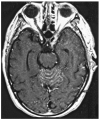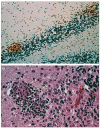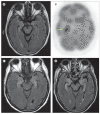Paraneoplastic syndromes of the CNS
- PMID: 18339348
- PMCID: PMC2367117
- DOI: 10.1016/S1474-4422(08)70060-7
Paraneoplastic syndromes of the CNS
Abstract
Major advances in the management of paraneoplastic neurologic disorders (PND) include the detection of new antineuronal antibodies, the improved characterisation of known syndromes, the discovery of new syndromes, and the use of CT and PET to reveal the associated tumours at an early stage. In addition, the definition of useful clinical criteria has facilitated the early recognition and treatment of these disorders. In this article, we review some classic concepts about PND and recent clinical and immunological developments, focusing on paraneoplastic cerebellar degeneration, opsoclonus-myoclonus, and encephalitides affecting the limbic system.
Figures





References
-
- Guichard MMA, Vignon G. La Polyradiculonéurite cancéreuse métastatique. Le J Médecine de Lyon. 1949:197–207. - PubMed
-
- Guichard MMA, Cabanne F, Tommasi M, Fayolle J. Polyneuropathies in cancer patients and paraneoplastic polyneuropathies. Lyon Medicale. 1956;41:309–29. - PubMed
-
- Antoine JC, Camdessanche JP. Peripheral nervous system involvement in patients with cancer. Lancet Neurol. 2007;6:75–86. - PubMed
-
- Rudnicki SA, Dalmau J. Paraneoplastic syndromes of the spinal cord, nerve, and muscle. Muscle Nerve. 2000;23:1800–18. - PubMed
-
- Rudnicki SA, Dalmau J. Paraneoplastic syndromes of the peripheral nerves. Curr Opin Neurol. 2005;18:598–603. - PubMed
Publication types
MeSH terms
Grants and funding
LinkOut - more resources
Full Text Sources
Other Literature Sources
Medical

